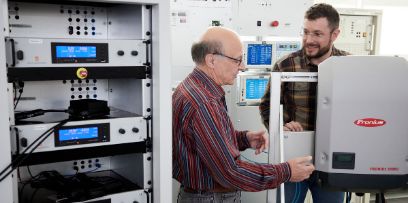- News
PV inverters have the ability to stabilise the power grid
13.07.2023 Instead of adopting expensive grid reinforcement measures, PV inverters can also be used to enhance grid stability. This is confirmed by a joint study conducted by the Laboratory for Photovoltaic Systems at Bern University of Applied Sciences BFH and Groupe E.
The growing number of PV systems poses a challenge for the stability of the electricity grid. To achieve this grid stability, distribution network operators (DSOs) mostly rely on traditional network reinforcement measures, such as replacing existing cables with cables with a larger cross-section. However, these solutions come with a high price tag. Which is why researchers from the Laboratory for Photovoltaic Systems at Bern University of Applied Sciences (BFH) teamed up with Groupe E in the recently completed GODA project to look into an alternative approach: voltage-dependent active power control, also called P(U), which can be activated in PV inverters. With P(U) control, the PV system curtails its output power (P) as soon as the voltage (U) exceeds a defined limit. In this way, the PV system itself remedies the voltage problem it has helped to cause. The P(U) control works decentrally and is not reliant on communication systems, making it a cost-effective and dependable solution.

Hardly any loss of energy yield
The project successfully adjusted the voltage-dependent active power control P(U) and tested it on PV systems in the field. The inverters demonstrated the desired reduction in active output when the grid voltage was too high, and limited the voltage to the programmed maximum value. Using self-learning algorithms that evaluated the smart meters’ production data, it was possible to calculate the production losses and compensate the system operators. What it also revealed: curtailing the output of a PV system in support of grid stability results in barely any loss of energy yield. This makes P(U) control a good alternative to costly grid reinforcement measures.